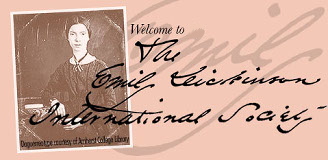

You are hereLambert, Nelly: "Emily Dickinson and the Persian Tradition: A Study in Drunkenness"
Submitted by nlambert on July 19, 2013 - 10:25am
Emily Dickinson and the Persian TraditionNelly Lambert, Catholic University Bees, wine, sweet nectar, intoxication, and androgynous address—these are just a few of the thematic interests that Emily Dickinson and the medieval Persian poetic tradition share. Although Ralph Waldo Emerson had read Hafez, and Dickinson had read Emerson, it is unlikely that Dickinson was closely familiar with many Persian authors. Yet the extent to which she favored the same approach to the topics of pleasure, longing, abundance, and the beauty of nature is striking if unwitting. It is as though the poetic eye, in two different eras and on two different continents, glimpsed the same garden, smelled the perfume of the same rose, and was amused by the same drunken bee. A comparison between Dickinson’s poetry and the Persian tradition sheds light on underappreciated strengths in both. Against an anachronistic Persian backdrop, the seemingly muted notes of Dickinson’s ecstasy are shown to be perfectly powerful and free; and with Dickinson’s poetry as its indirect proto-modern descendant, the philosophical and aesthetic playfulness—the surprising funniness— of the Persian tradition becomes more apparent. Thus, briefly outlining the remarkable degree to which Dickinson drew on Persian poetic conventions (such as delighting in inebriation, nature’s lush beauty, banter with God, or the paradox of indulgence and renunciation), this paper first raises questions about the roles of opulence—material and spiritual—lushness, and pleasure in poetry, and whether they carry a special tenor that persists across technologies, fashions, and time. Next, this paper will flesh out the broader comparison through a parallel study of Dickinson and the medieval Persian poet-princess Jahan Malek Khatun, focusing first on their shared tropes of androgynous address, ecstasy in suffering, and savvy broadmindedness when it comes to broken hearts. Since both were unique in their time for maneuvering around conventional expectations for women poets, there is much to be gained in placing them side-by-side. Moreover, the far lesser-known medieval-era Khatun on the one hand faced harsher punishments for her vocation, such as imprisonment and banishment; on the other hand, she could express things more directly in her poetry, whereas Dickinson’s banished “nobodies” had to speak in “circuit” lest they face a deeper form of banishment. The comparison to Khatun will lead into a discussion of the larger issues in aligning Dickinson with medieval Persian poetry. Like Chaucer and Rabelais, among other medieval and early Renaissance writers, Dickinson’s poetry joins together the high and the low, the delicate and the harsh, the insignificant and the vast. Yet Dickinson’s manner of exploding social and philosophical paradigms more closely resembles the Persian, rather than the western, medieval poet—the poet who makes binaries shaky simply by abruptly shifting from one image in a ghazal to another. The passionate quality of the Persian style and themes throws into relief the similarly passionate and intense, yet playfully subversive waves of longing in Dickinson’s poetry.
|